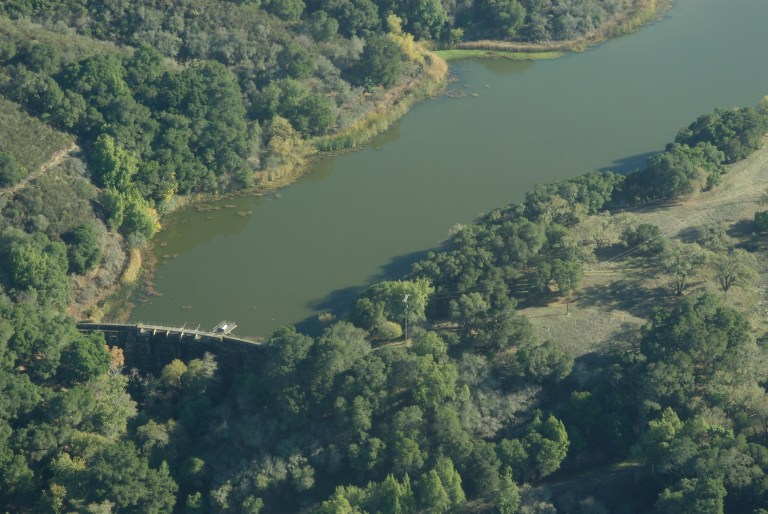The National Oceanic and Atmospheric Administration (NOAA) has confirmed that Stanford University is under federal investigation for potential criminal violation of the Endangered Species Act (ESA) in its operation of Searsville Dam. Investigators are probing University activities for the potential threat to steelhead trout, classified as an endangered species by NOAA.
According to Jim Milbury, a National Marine Fisheries Service public affairs representative, the investigation surrounds the question of whether the University is responsible for steelhead trout “take,” which according to the ESA means, “to harass, harm, pursue, hunt, shoot, wound, kill, trap, capture, or collect [an NOAA listed animal] or attempt to engage in any such conduct.” In the past, this has covered a broad range of violations including blocking migratory passages and altering water supply.
No Stanford affiliate interviewed would comment on how the investigation would affect current operations at Jasper Ridge or at the University in general.
Operated by the University since 1919, the 65-foot-tall Searsville Dam was built in 1892 for water storage. The dam blocks steelhead trout from migrating to their historical habitat, and has spurred sedimentation that has reduced Searsville Lake to under 10 percent of its former capacity. According to a 2011 University press release, Stanford still uses the reservoir as a major source of the one million gallons in non-potable water supply used every day, including for irrigation and landscaping.
The University maintains that the dam is necessary water supply needs and protection of a new habitat that has sprung up after the dam’s construction. The University has also said the dam is important for flood concerns. However, the dam’s opponents argue that, in addition to controversial maintenance, the dam is unsafe. Stanford has not completed thorough inspection recommended by the California Division of Safety of Dams in 2007.
Dam-removal advocates also maintain the Searsville Dam is illegal because it violates the Endangered Species Act.
“It appears to us that Stanford intentionally did not tell the federal government about certain activities and construction they undertook because there were obvious connections to ESA issues,” said Matt Stoeker, a restoration ecologist and founder of Beyond Searsville Dam, a nonprofit organization advocating for the destruction of Searsville Dam.
In 2008, Stanford’s Board of Trustees introduced their Habitat Conservation Plan (HCP) as part of an application for a 50-year Incidental Take Permit for four endangered species. If granted, the permit would allow the University to continue its normal activities and operations despite incidental harm to the covered animals.
Searsville Dam was excluded from the report pending an Alternative Study, for which Stanford chartered a steering committee composed of five faculty members.
On Dec. 6, 2012, Catherine Palter, associate director of land use and environmental planning, wrote a letter to NOAA on behalf of the University suspending Stanford’s application for the Incidental Take Permit for activities in the San Francisquito Creek Basin, where the dam is located, until the Alternative Study was completed.
However, Jasper Ridge Director and Steering Committee Co-chair Chris Field said that the committee has always had more long-term and big-picture goals for managing the watershed.
“In general, the Searsville steering committee wasn’t put together to manage… the [dam’s] near-term issues,” he said.
Both Milbury and Field said that they were not sure what prompted law enforcement to open the investigation.
“There is no question in my mind that they are causing take of steelhead and other species,” Stoeker said. “The feds don’t open a case [or] investigation into ESA violations unless they’re pretty confident that they’re going to find something.”
Stoeker also argued that Stanford was also under investigation for lacking the proper regulatory permits to operate the dam. He questioned whether Stanford properly notified the California Department of Fish and Game when it installed new booster pumps in the Searsville Diversion facility around 2008 despite a law requiring an entity to submit notice when it “substantially divert[s] or obstruct the natural flow of… any river, stream or lake.”
“[The investigation] is going to make Stanford realize that they can’t keep doing what they’ve been doing,” Stoecker said. “They’re going to have to make serious modifications to the dam or remove the dam to get into compliance with the [ESA].”
According to Milbury, “whoever operates the Searsville Dam” may face criminal charges if investigators find evidence of endangered species take.
“Under Section 9 of the ESA, there are penalties for taking endangered species,” he explained. “In this case there are criminal violations: no more than $50,000 per count, or imprisonment for not more than one year.”
